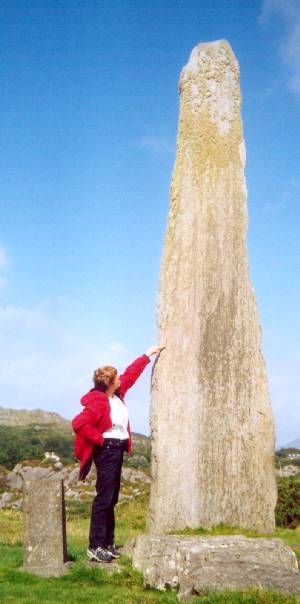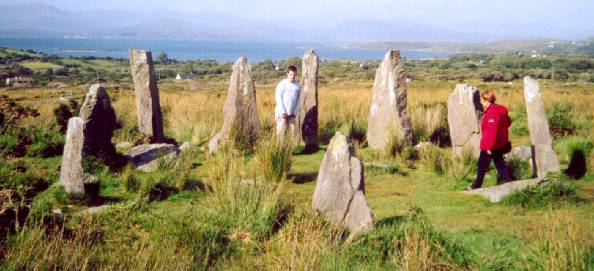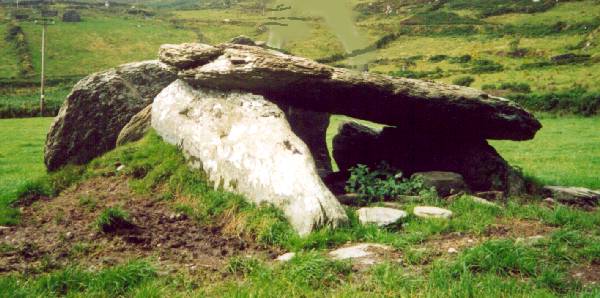Ireland: testimonies
of the age of the Bronze
The sites of Beara's peninsula
Standing Stone (Menhir), Ogham
Stone, Stone Circle , Neolithic Grave
(Dolmen)
 Version
française
Version
française
Standing Stones (or menhir in Breton).
Standing stones are numerous in Celtic areas. They go back up to a period
spreading out of the age of the bronze ( 1500 ) in the arrival of the first
Christians. Their function is not exactly known, but hypothéses is numerous:
grave, religious site, commemorative stone of important, even simple event
stands out with territory or terminal of ancient road.

Marina tries to raise the stone |

Beara's peninsula
|
| Ogham Stones
Ogham Stone is a particular case: they contain registrations in a simple
alphabet but a suit of 20 signs. These signs are formed by one in five
lines, rights or obliques, situated on both sides by a median line.
In the case of Ogham stones, the median line is a fish bone of the stone.
They are read in the bottom at the top. It is certain that these signs
are widely later than the implementation of stones, and date first centuries
of our era.
The appelation Ogham or Ogam comes from the name of the Celtic god Ogma,
the god of the Literature and the Eloquence, the son of the goddess
of the Wisdom, Brig.
|

The detail of the signs Ogham of Ballycrovane's stone with the interpretation
of the last word of the registration:
TURANIAS |
| The Ogham stone of Ballycrovane:
It is situated in 3km in the North of Eyeries, in the peninsula of
Beara, in 300m of a small port.
The Ogham stone of Ballycrovane is the highest of Europe with her 5.2m
and perhaps the most beautiful.
The registration was interpreted:
AVI MAQI-DECCEDDAS TURANIAS
Or: of the son of Decched, from Torain
|

The Ogham stone of Ballycrovane |

The alphabet Ogham used on Ballycrovane stone is called " Beth-Luis-Fearn
", of the name of the first three letters
|
Stone circles
Stone circles were built between 1500 and 500 before JC. They have between
5 and 19 stones. Often a central stone is present and the lowest stones are
steered towards the southwest, contrary to the higher 2 which bound a portal.
Gravestones are found inside or near the circle. The hypotheses of use are varied:
religious or funeral rites, look-out post of the sun or the moon, the huge calendar.

Ardgroom stone circle:
It is situated in the North of Beara peninsula, 2km east of Ardgroom ( Dhà
Dhrom's ) village
|
Ardgroom circle measures 7,5m of diameter.
It contains 9 stones up and 2 slept. The gate is formed by 2 stones
of 2m of height steered towards the North - northeast.
Original characteristic: stones are cut sharp.
In 6m of the circle an outside stone of 2,5m of height is steered,
not towards the centre as in the other sites, but tangentiellement towards
the south edge of the circle; an unrefined pavement connects the circle
with this outside and continuous stone farther.
|

O=çàutside stone of Ardgroom
|
Neolithic grave

Neolithic grave of Kilough
Situated in 4,5 km in the southwest of Alihies, near the extremity of Beara's
peninsula







